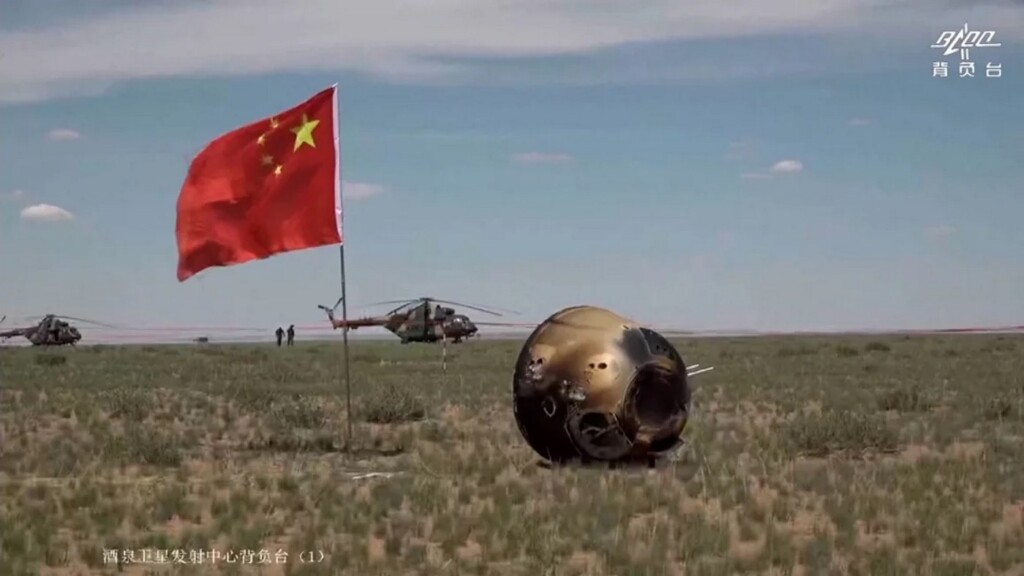China’s Lunar Probe Returns World’s First Samples from Far Side of the Moon

China has become the first nation to gather samples from the Moon’s far side after the Chang’e-6 mission’s re-entry capsule touched down in Inner Mongolia yesterday.
Containing 4.4 pounds of rocks and dust—known officially as ‘regolith,’ the sample-return mission has been hailed as a milestone achievement by scientists who eagerly await what geological secrets the samples may hold.
The Chang’e-6 probe touched down on the Moon’s South Pole-Aitken Basin on June 1st. The lander module drilled for samples using a robotic arm and scoop, which were then stored in its hull where the ascent module took them back into space to rendezvous with the orbiter module.
Once onboard, the samples were shot back to Earth where they parachuted down onto the grass of the rural Siziwang Banner region of Inner Mongolia.
It followed five successful lunar missions (Chang’e 1 through 5) that included establishing a weather station on the Moon’s far side in Chang’e-4—the first time any craft had made it there, and a sample return mission from the polar region with Chang’e-5, which brought back the first Lunar samples since the Apollo missions.
“It’s a gold mine … a treasure chest,” James Head, a professor of planetary geosciences at Brown University, who was able to analyze regolith from the Chang’e-5 mission told CNN. “International scientists are totally excited about the mission.”
“This is a great achievement by China,” said Martin Barstow, a professor of astrophysics and space science at the University of Leicester. “Recovering any samples from the moon is difficult, but doing so from the far side, where communications are particularly difficult is a step taken by no other agency. A real technological feat.”
IS THERE LIFE ON MARS?: Ancient Lake Sediment on Mars Builds Excitement for Evidence of Life in the Perseverance Rover Samples
Scientists like Barstow and Head have several key interests in the samples. Since the Moon is tidally locked, the far side is never seen, but that doesn’t mean there’s nothing to see. In fact, the far side should contain a frozen record of the nature and character of the Moon and Earth during their earlier years.
Plate Tectonics have eliminated or obscured features and evidence of Earth’s earliest periods, but since there are no Plate Tectonics on the Moon, a continuous record from the beginning to the end should be found there.
WHAT THE LAST SAMPLES CONTAINED: China’s New Moon Rock Samples Contain Beautiful Crystal New to Geology
Additionally, the far side is covered with impact craters rather than the ‘maria,’ or frozen lava plains which cover the near side. The hope is that the South Pole-Aitken Basin should be able to tell scientists how many craters were formed during the Late Heavy Bombardment, a period lasting between 20 and 200 million years when the early Earth was under continuous pummeling by asteroids and even small planetesimals.
The chief interest in studying the Late Heavy Bombardment—a difficult task on Earth because of Plate Tectonics—is to see if it supports one theory of how life on Earth emerged: namely that water and other elements crucial for life were deposited during this period via the asteroids and failed planets colliding with our world.
FROM AN ASTEROID: Asteroid Sample Delivered Back to Earth in a ‘Brilliant Feat’–a Time Capsule of Ancient Solar System
Chang’e-6 is the last sample-return mission in the Chang’e mission series, with missions 7 and 8 slated for in-situ experiments destined to inform and assist a permanent Chinese robotic base on the Moon.
The Chinese space program has come on leaps and bounds in the last 6 years. Missions Chang’e 4 and 5, the latter being a sample return mission, were complete successes. Following Chang’e-5’s landing, but before the return of the samples, the CNSA became the only space program to see its first orbiter, first lander, and first rover sent to Mars all succeed on the first time of asking.
SHARE This Giant Leap For Mankind With Your Friends…
>read more at © GoodNews
Views: 9